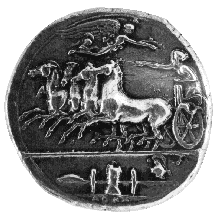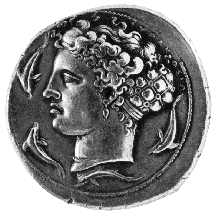



(18) Syracuse, Sicily (Italy) - AR dekadrachm, c. 405-400
B.C., 43.15 g. (inv. 91.033).
Obverse: Victorious quadriga l.; cuirass, helmet, shield,
and greaves in exergue; below, ![]() : prizes.
: prizes.
Reverse: Head of Arethusa l., with band and net holding
hair, surrounded by four dolphins; ![]() : of the Syracusans.
: of the Syracusans.
Provenance: Ex Pennisi collection; Bank Leu, 1973.
Bibliography: G.E. Rizzo, Monete greche della Sicilia
(Rome 1946), 50.6; J.H. Jongkees, The Kimonian Decadrachms (Utrecht
1941) 11.
This coin is attributed to the master engraver Kimon, whose works, like
those of the other great Syracusan engraver, Euainetos, were imitated by
the mints of other cities. The obverse, as in the reverse of his dekadrachm
with the facing Arethusa (see no. 17), depicts a
racing quadriga. The charioteer and the front horse cross the beaded outline
of the coin and seem to break free of the framing constraints. The composition
has smooth modeling and intricate details.
The military equipment along with the word "prizes" in the exergue
had long led numismatists to associate them with the booty awarded as prizes
in games celebrating the Syracusan victory over Athens in 413 B.C. There
is, however, no evidence for the games, and it is now generally believed
that the coins are later, possibly issued by Dionysios I to celebrate the
failed Carthaginian attack on Syracuse in 405 B.C.
On the reverse is the Syracusan nymph Arethusa, for whom the fresh water
spring on the Syracusan island of Ortygia was named. The dolphins encircling
her head probably refer to the location of the spring on the island. On
this coin Arethusa wears an ampyx or hairband, on which Kimon frequently
signed his name, and has the rest of her hair caught up in an intricate
net.
K.S.



All contents copyright (c) 1996.
Lawrence University
All rights reserved.